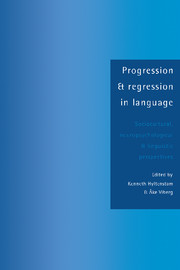 Progression and Regression in Language
Progression and Regression in Language Book contents
- Frontmatter
- Contents
- List of contributors
- Preface
- INTRODUCTION
- THE SOCIOCULTURAL SETTING
- PSYCHO- AND NEUROLINGUISTIC ASPECTS
- THE LINGUISTIC PERSPECTIVE 1: DISCOURSE, GRAMMAR, AND LEXIS
- THE LINGUISTIC PERSPECTIVE 2: PHONOLOGY
- 16 The development of phonological abilities
- 17 The course of development in second language phonology acquisition: a natural path or strategic choice?
- 18 Sociolinguistic factors in loss and acquisition of phonology
- Index
18 - Sociolinguistic factors in loss and acquisition of phonology
Published online by Cambridge University Press: 06 July 2010
- Frontmatter
- Contents
- List of contributors
- Preface
- INTRODUCTION
- THE SOCIOCULTURAL SETTING
- PSYCHO- AND NEUROLINGUISTIC ASPECTS
- THE LINGUISTIC PERSPECTIVE 1: DISCOURSE, GRAMMAR, AND LEXIS
- THE LINGUISTIC PERSPECTIVE 2: PHONOLOGY
- 16 The development of phonological abilities
- 17 The course of development in second language phonology acquisition: a natural path or strategic choice?
- 18 Sociolinguistic factors in loss and acquisition of phonology
- Index
Summary
First language loss or language attrition can refer to the diminishing competence in a language, varying in degree from complete loss, such as language death (Dressier, 1972), to loss of proficiency (Sharwood Smith, 1983a and 1983b), to change in language contact situations (Weinreich, 1953; Clyne, 1972, 1980; Weltens, de Bot, and van Els, 1986). Although LI loss can occur in cases of isolation from all language use, in most cases LI loss includes concomitant learning of an L2 and integration into the L2 culture. Thus, second language acquisition and first language loss seem to be inextricably linked. In general, it is reasonable to assume that the better one does at L2 language and culture the more likely that person will undergo LI loss. That this is true seems readily apparent when one contrasts extreme cases. An American who learns three words in Japanese is unlikely to suffer loss of English while one who has spent the last 20 years in Japan probably will.
A number of social and affective factors have been linked to second language acquisition such as cultural identity, attitude, motivation (integrative vs. instrumental, Gardner, 1985), accommodation (Beebe and Giles, 1984), ego permeability, the affective filter, and risk-taking. Because a high degree of proficiency in L2 has been linked to LI loss, it would be reasonable to investigate whether these factors mentioned above also relate to LI loss. For example, if x and yare correlated with L2 acquisition, but only y is correlated with concomitant LI loss, this would tell us something important about the differences of these factors in LI loss and L2 acquisition.
- Type
- Chapter
- Information
- Progression and Regression in LanguageSociocultural, Neuropsychological and Linguistic Perspectives, pp. 463 - 478Publisher: Cambridge University PressPrint publication year: 1994
